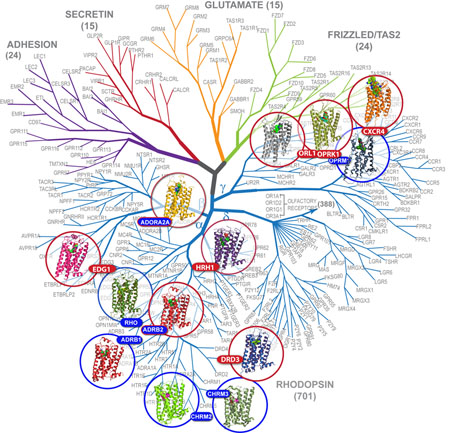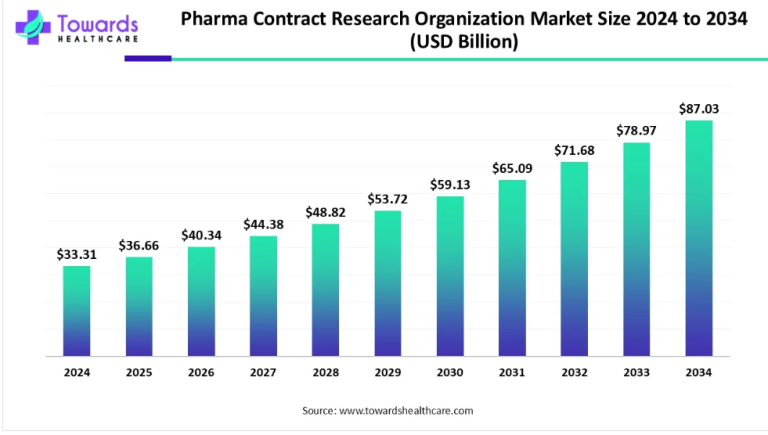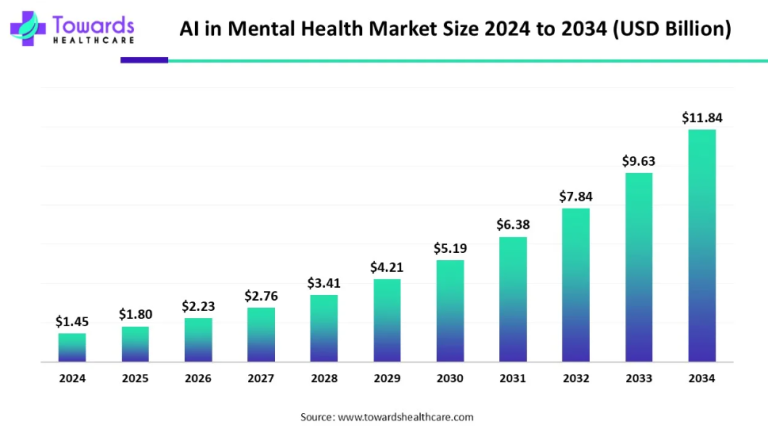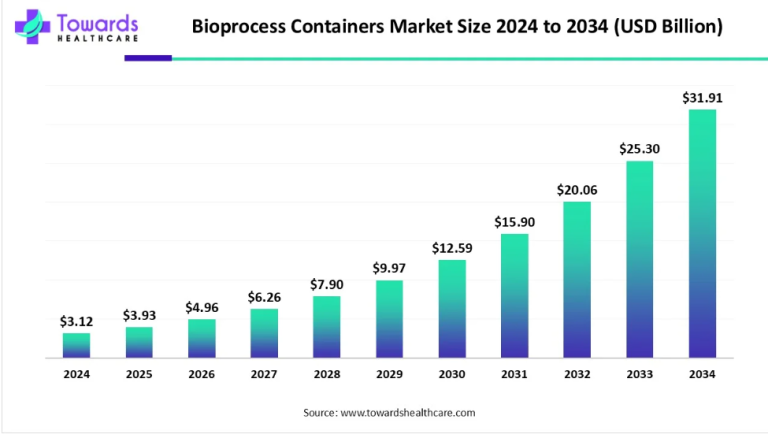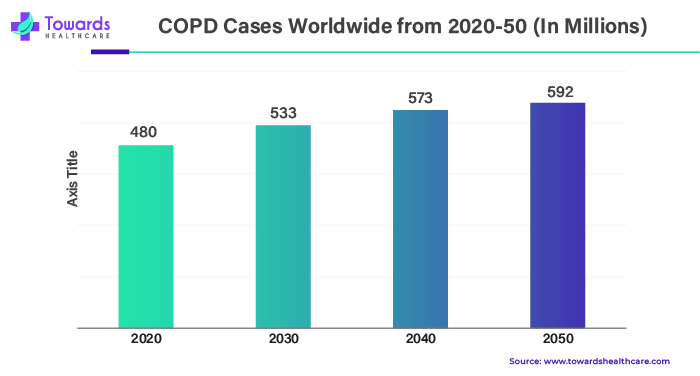
The Rising Prevalence of COPD Drives Market Growth Amidst High Treatment Costs and New Biologic Therapies
Chronic Obstructive Pulmonary Disease (COPD) cases are on the rise globally, with major contributing factors including smoking and air pollution. According to the World Health Organization (WHO), COPD is the third leading cause of death worldwide, with 90% of COPD-related deaths occurring in middle- and low-income countries. Smoking is responsible for 70% of COPD cases, while other significant contributors include air pollution, occupational hazards, second-hand smoke, and genetic disorders such as Alpha-1 antitrypsin deficiency. Research published in the International Journal of COPD indicates that 70-80% of cases remain undiagnosed. However, advancements in research and technology are improving diagnosis rates, thereby driving growth in the chronic obstructive pulmonary disease market.
High Cost of Treatment May Restrain Market Growth
The treatment cost for COPD is high due to the chronic nature of the disease, which requires continuous monitoring, medication, and treatment. Acute exacerbations of COPD account for the majority of morbidity, mortality, and medical expenses, with frequent exacerbators facing the highest costs. Healthcare expenditures for COPD patients include maintenance therapy medications, outpatient care, and treatment for exacerbations, such as hospital stays. The disease necessitates the use of expensive anti-fibrotic and immunosuppressive medications, which have significant adverse effects and contribute to the high cost of treatment. This financial burden is particularly challenging for developing and underdeveloped countries, potentially restraining market growth.
For example, adults aged 45 and older incur annual medical costs of $24.0 billion due to COPD. These costs include $11.9 billion for prescription drugs, $6.3 billion for inpatient care, $2.4 billion for office-based care, $1.6 billion for home health care, $900 million for emergency room visits, and $800 million for outpatient care. The average annual cost of medical care for COPD patients is $4,322.
Download a sample of this report @ https://www.towardshealthcare.com/personalized-scope/5154
New Biologic Therapies Create Market Opportunities
The development of novel biological therapeutics for COPD treatment is a significant advancement in this field. Biologic treatments, such as monoclonal antibodies, have revolutionized the treatment of many human diseases. These injectable drugs, derived from live cells or other biological components, target specific immune pathways. There is optimism that biologic medications currently used to treat related respiratory disorders, such as asthma, will soon enter the chronic obstructive pulmonary disease market.
For instance, in November 2023, the second positive Phase 3 study of Dupixent® significantly reduced COPD exacerbations, indicating its potential to become the first authorized biologic for this critical illness and expediting the FDA submission process. The NOTUS study demonstrated that Dupixent reduced exacerbations by 34% compared to placebo in patients with moderate-to-severe COPD exhibiting type 2 inflammation, meeting its primary goal with overwhelming effectiveness. Additionally, Dupixent rapidly and markedly improved lung function.
These developments highlight both the challenges and opportunities within the COPD market, driven by increasing disease prevalence, high treatment costs, and innovative therapeutic advancements.
Chronic Obstructive Pulmonary Disease Market Overview and Regional Insights (2023)
By Disease Type
In 2023, the chronic bronchitis segment led the market by disease type. Chronic bronchitis, a form of COPD characterized by persistent bronchial irritation and mucus build-up, remains incurable despite available therapies. Emphysema, another form of COPD, is rapidly expanding in prevalence, particularly among males, older individuals, and those with extensive smoking histories. Factors contributing to this trend include rural residency and greater occupational exposure. Current treatments, such as inhaled mucolytics and recombinant human DNase, have shown limited effectiveness. Potential therapies under investigation include oscillating positive expiratory pressure therapy, long-acting muscarinic antagonists, oral mucolytics, antioxidants, and smoking cessation. Additional therapies like targeted lung denervation, liquid nitrogen-metered cryospray, and rhinoplasty are also being explored for chronic bronchitis.
By Treatment Type
Drugs dominated the COPD treatment market in 2023, helping manage symptoms and improve lung function. Bronchodilators (e.g., albuterol, tiotropium) open airways, corticosteroids reduce inflammation, and phosphodiesterase-4 inhibitors (e.g., roflumilast) decrease severe exacerbations. These medications, typically delivered via inhalers or nebulizers, provide a less invasive and more convenient treatment option compared to surgery or oxygen therapy, which are reserved for emergencies. Notably, Verona Pharma plans to introduce ensifentrine, a dual phosphodiesterase (PDE) 3/4 inhibitor, in the U.S. by Q3 2024 pending FDA approval.
Oxygen therapy is expected to grow the fastest among treatment types, particularly for patients with severe hypoxemia. Long-term oxygen therapy (LTOT) has proven survival benefits and is extensively used in the U.S., with Medicare spending over $2 billion annually. Belluscura’s X-PLOR portable oxygen concentrator, approved for distribution in Singapore in January 2024, highlights advancements in oxygen enrichment technology.
By End-User Type
Hospitals and clinics dominated the COPD market by end-user type in 2023 due to frequent hospital admissions for exacerbated respiratory symptoms. COPD patients account for 2% of emergency room visits, with a significant proportion requiring hospitalization. Studies indicate high readmission rates post-discharge, with 37% of patients readmitted within 90 days. This reflects the chronic and recurrent nature of COPD, necessitating consistent hospital-based care.
Regional Insights
In 2023, North America led the COPD market, driven by the U.S. and Canada. In the U.S., around 16 million individuals have COPD, with women constituting more than half of the diagnosed cases. The CDC identifies COPD as the sixth leading cause of death in the U.S., with costs projected to rise to $40 billion annually over the next two decades. Efforts to enhance COPD diagnosis include screening and case-finding initiatives supported by the USPTF and GOLD guidelines.
The American Lung Association’s initiatives, including the Breathe Better Network and state-specific COPD prevalence profiles, aim to raise awareness and improve early diagnosis. A forthcoming COPD National Indicator Report in 2024 will provide further insights into disease management and prevention.
The Asia Pacific region is expected to grow the fastest during the forecast period, with significant contributions from India, China, and Japan. India, with 8% of its population affected by COPD, faces substantial economic losses due to inadequate disease management. Efforts to introduce advanced treatments, such as Lupin Limited’s Vilfuro-G®, aim to address this challenge.
China, accounting for nearly 25% of global COPD cases, is focusing on improving primary healthcare capabilities for early COPD detection and management. A national initiative has trained over 140,000 primary healthcare providers in pulmonary function testing, aligning with WHO’s global strategies for noncommunicable disease prevention and control.
The global COPD market is characterized by significant advancements in treatment options, regional disparities in disease prevalence and management, and ongoing efforts to enhance early diagnosis and patient care.
To own our research study instantly, Click here @ https://www.towardshealthcare.com/price/5154
Read More about Chronic Obstructive Pulmonary Disease Market:
- Chronic Obstructive Pulmonary Disease Market Size
- Chronic Obstructive Pulmonary Disease Market Companies
You can place an order or ask any questions, please feel free to contact us at sales@towardshealthcare.com
About Us
Healthcare Web Wire is a premier subsidiary of Towards Healthcare, dedicated to providing comprehensive insights and information related to the healthcare industry. With a commitment to delivering accurate and timely updates, Healthcare Web Wire serves as a vital resource for professionals, enthusiasts, and stakeholders within the healthcare sector. Our platform serves as a central hub for the latest news, trends and developments shaping the healthcare landscape. Join us on Healthcare Web Wire and become part of a vibrant community dedicated to advancing healthcare knowledge and shaping the future of healthcare worldwide.
Explore the comprehensive statistics and insights on healthcare industry data and its associated segmentation: Get a Subscription
For Latest Update Follow Us: https://www.linkedin.com/company/towards-healthcare

